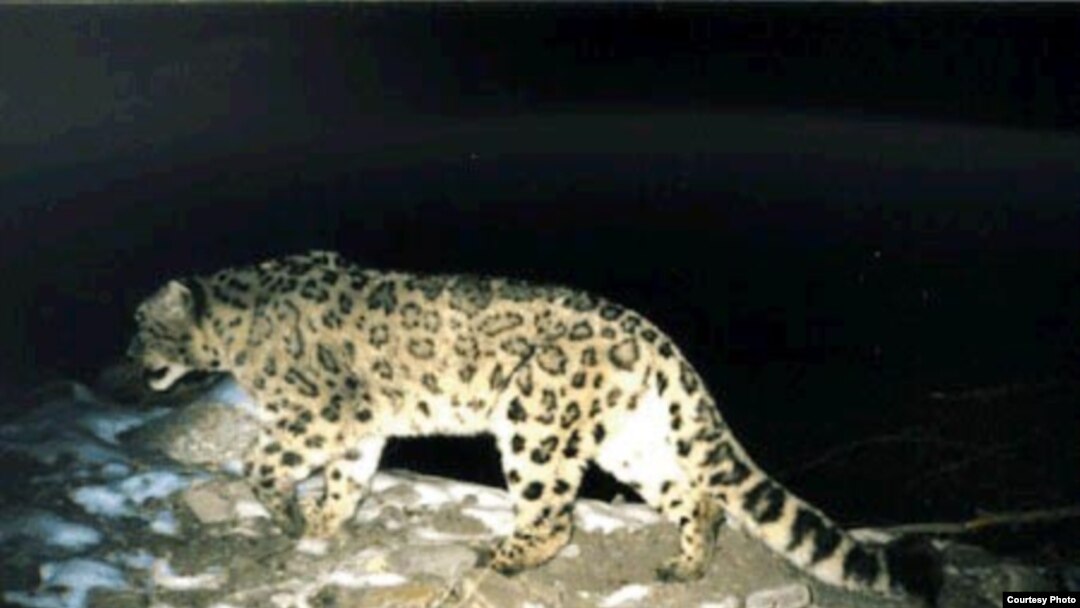PRAGUE, March 16, 2006 (RFE/RL) -- The habitat of snow leopards covers 12 countries -- including Afghanistan, China, Kazakhstan, Kyrgyzstan, Russia, Tajikistan, and Uzbekistan.
Although the animal is legally protected throughout this area, only about 7,000 are thought to still survive in the wild. More than half of them are in China.
Snow leopards are killed for their fur and for their bones -- which are used in traditional Asian medicine. They also are killed in retaliation for preying on livestock. Amankul Bikenov, from the Almaty Institute of Zoology in Kazakhstan, tells RFE/RL that the animal also suffers because of the disappearance of its normal prey.
"In our territory there are only 250 to 300 [snow leopards]," Bikenov says. "What we do is try to locate and preserve them in special national parks. But despite these measures, their numbers are dwindling. It can be explained by the decrease of other species they use as food, such as Marco Polo sheep, wild goats, and others."
Public Awareness Needed
Almaz Musaev is the head of the hunting department at the Kyrgyz Environmental Protection and Forestry Agency. He says fewer than 300 snow leopards still survive in Kyrgyzstan. Musaev suggests a large-scale public awareness campaign is needed to help protect them.
"Our previous activities to protect the snow leopards have been insufficient," Musaev says. "Because there is a need to make every Kyrgyz citizen aware of the [situation], we need to hold the leopards in high respect as the Indians deify the cow there. Without such actions, the work of our few staffers will fail."
Musaev also concedes that the issue can not be resolved without the help of the international community.
At Akshiyrak and Engilchek, two villages In Kyrgyzstan's Issykkul region, a U.S.-based organization called the Snow Leopard Trust is trying to help people increase their household income in a way that also helps protect snow leopards and their habitat.
Together with local partners, the Snow Leopard trust provides herders with training and equipment to produce handicrafts using wool from their livestock. These products are marketed at stores in the United States and through the Snow Leopard Trust's website.
In return, participating communities agree not to kill snow leopards or the wild animals that they eat. If even one person violates the contract, the entire community loses a cash bonus made available at the end of each year.
The Snow Leopard Trust's Tom McCarthy tells RFE/RL that handicraft sales allow some families to nearly double their annual income -- and that is without taking into account the bonuses.
"Their average annual income just from the handicraft sales is about $145," McCarthy says. "And they might only lose one or two livestock a year to snow leopards. They're very happy, then, not to kill those animals in exchange for keeping this handicraft project going."
McCarthy says the project model has been successful so far. He says his organization expects to expand the program to include other Kyrgyz villages later this year.
But he says it is sometimes difficult to measure the program's impact on the snow leopards' population.
In order to establish the current status of snow leopards and to determine where they live, the Snow Leopard Trust has helped fund a study in both Kyrgyzstan and China's Xinjiang region.
Hidden Cameras
Scientists last year placed cameras with infrared detectors in the remote Tien Shan Mountains along the Kyrgyz-Chinese border. During several weeks, the cameras took 13 pictures of snow leopards on the Kyrgyz side of the mountains and 40 on the Chinese side. Samples of snow leopard feces also were collected.
A Kyrgyz villager creates handicrafts to raise funds to protect the snow leopard (Snow Leopard Trust)
"In China we put the cameras in very good places and took many pictures," Ma said. "But this [doesn't] mean the Chinese population [of snow leopards] is big. It is too early. We must do research, we must continue [the] hard work."
The photographs are now being studied to see how many different leopards can be identified. Meanwhile, the feces samples have been sent to genetic laboratories for analysis. Scientists hope the data will provide a better idea of how many snow leopards are still alive -- and where they are living.
(RFE/RL's Kazakh and Kyrgyz Services contributed to this report.)


